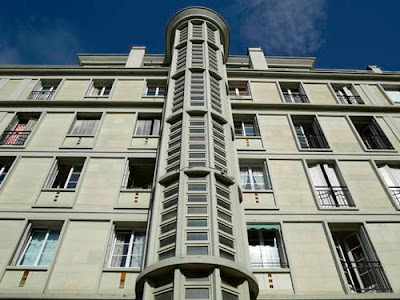The city of Le Havre , on the English Channel in Normandy Le Havre Le Havre
Criterion (ii): The post-war reconstruction plan of Le Havre
Criterion (iv): Le Havre
The post-Second World War reconstruction plan of Le Havre
Being at the mouth of the river Seine, the site of Le Havre was always strategic for access inland, to Rouen and Paris Rouen America Le Havre (harbour) continued developing its commercial links with America and Africa . Minister Colbert authorized the construction of an arsenal, transferring the naval dockyards to the area of Perrey.
The plan to rebuild Le Havre Paris
Taking into account the soil conditions and high water table, it was proposed to construct the entire city on a reinforced concrete platform about 3.50 m above ground level, a revolutionary initiative that would have facilitated the building of infrastructures. Owing to the limits of cement and iron in the post-war period, it was not authorized, although the general master plan was carried out. The project was based on a basic grid module of 6.24 m2 . The lots were laid out on a 100 m grid, although some were combined to make larger lots. Construction lasted until 1964, when the Church of Saint-Joseph was consecrated.
The project corresponds to the architect's ideal to create a homogenous ensemble, where all the details are designed to the same pattern, thus creating a kind of Gesamtkunstwerk in the urban scale. Perret reserved some of the most important public buildings as his personal design projects. A few buildings that had not been destroyed in the bombardment were retained as part of the new town scheme. Even though the Saint-François quarter was also destroyed, several historic buildings remained standing, and were protected in 1946. As a result, the plan of this area was mainly based on the old street pattern.
Basing the design of the buildings and open spaces on 6.24m square module of a square was to facilitate the production, but also to introduce 'musical harmony' into the city. The average density was reduced from the pre-war 2,000 to 800 inhabitants to a hectare. The spirit of the town was conceived as 'neoclassical', where the building blocks are closed and the streets remain streets. The essence of Perret's project is in structural design, which was based on an avant-garde use of reinforced concrete elements, a system called poteau dalle. The idea of the structure is to make it modular and completely transparent so that no structural elements remain hidden. This gives the dominating character and a certain uniformity to all architecture. However, the elements are used in skilful way so as to avoid boredom.
The Porte Océane is a monumental entrance to Avenue Foch and an entrance to the city from the sea, taking the idea of the ancient gate destroyed in the war. This building also became an experimental 'laboratory' for the development of the structural system and methods of construction for the project. The square Saint-Roch is located in the place of an earlier public park and cemetery, which has given some its orientations to the new design. The Hôtel de Ville (town hall) is the most monumental structure in the whole scheme and its central part is marked by an 18-storey tower 70 m high.
Being at the mouth of the river Seine, the site of Le Havre was always strategic for the access to the inland, to Rouen and Paris Rouen America , the port gained in importance, and in 1541, Kind François I commissioned architect J. Bellarmato from Siena Le Havre (meaning ‘harbour') continued developing its commercial links with America and Africa . Minister Colbert authorised the construction of an arsenal, transferring the naval docks to the area of Perrey. It was from here that Lafayette started his trip to go to fight America
At the end of the 18th century, Le Havre was one of the four principal ports of France Paris to Rouen and to Le Havre
At the start of the Second World War, the harbour of Le Havre Britain
The idea to rebuilt Le Havre school of Beaux-Arts Paris
Taking into account the soil conditions and high water table, it was proposed to construct the entire city on a reinforced concrete platform about 3.50m above the ground level. At the time, this was a revolutionary initiative, and would have facilitated the building of infrastructures. Due to the limits of cement and iron in the post-war period, it was not authorised however. The general master plan was however carried out. The project was based on the basic grid module of 6.24m square. The lots were planned in a 100m grid, though some of these were united to make larger lots. The construction lasted until 1964, when the church of Saint-Joseph was consecrated.
























Niciun comentariu:
Trimiteți un comentariu